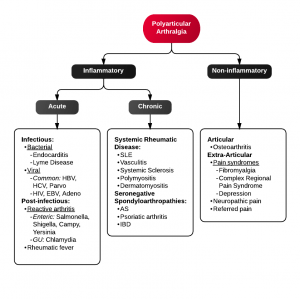Acute rheumatic fever
Background
- Primarily affects school age children 2-6 weeks after strep pharyngitis
- Connective tissue of heart, joints, CNS, subcutaneous tissues are targeted by immune reaction
Clinical Features
- Polyarthritis
- Most common symptom (75%)
- Migratory, fleeting polyarticular arthritis primarily affecting large joints
- Carditis (33%)
- Most serious complication and second most common
- Tachycardia out of proportion to the degree of fever is common; its absence makes the diagnosis of myocarditis unlikely.[1]
- New murmur, pericardial rub, CHF
- Chorea (10%)
- May appear months following strep infection, may be sole manifestation of RF
- Erythema marginatum (< 10%)
- Persists only for several days
- Usually coexists with presence of carditis in some form
- Nonpruritic rash, located on trunk and proximal limbs, never on face
- Nodules(< 10%)
- Located on extensor surfaces of wrists, elbows, knees
Differential Diagnosis
- Scarlet fever
- Kawasaki Disease
- Viral or other forms of cardiomyopathy
- Leukemia
- Vasculitis (HSP, drug reaction)
Polyarthritis

Algorithm for Polyarticular arthralgia
- Fibromyalgia
- Juvenile idiopathic arthritis
- Lyme disease
- Osteoarthritis
- Psoriatic arthritis
- Reactive poststreptococcal arthritis
- Rheumatoid arthritis
- Rheumatic fever
- Serum sickness
- Systemic lupus erythematosus
- Serum sickness–like reactions
- Viral arthritis
Evaluation
Modified Jones Criteria (1992) for Acute Rheumatic Fever
REQUIRE: 2 major or 1 major and 2 minor criteria and evidence of previous GAS pharyngitis
- Major diagnostic criteria (CASES)
- Carditis (new or changing murmur, cardiomegaly, CHF, pericarditis)
- Arthritis, migratory polyarthritis (typically affects knees, ankles, elbows, wrists)
- Sydenham's Chorea (abrupt, purposeless movements)
- Erythema marginatum (non-pruritic, trunk/extremities, with facial sparing)
- Subcutaneous nodules (painless, firm, usually over bones/tendons)
- Minor diagnostic criteria
- Fever
- Arthralgia
- History of previous attack of rheumatic fever
- Prolonged PR interval
- Elevated ESR, CRP
- Evidence of preceding streptococcal infection
- Increased ASO or other strep ab
- Positive throat culture for Group A strep
- Positive rapid GAS
- Recent scarlet fever
Management
- Penicillin - Indicated for all with rheumatic fever even if culture for strep is negative
- Penicillin G 600K units IM if <27 kg, 1.2 million units IM if >27 kg
- Penicillin V PO x10d
- Erythromycin x10d if penicillin-allergic
- Prophylaxis
- Penicillin G IM x1 month
Category Duration Rheumatic fever without carditis 5 years or until age 21 years, whichever is longer Rheumatic fever with carditis but without residual heart disease (no valvular disease) 10 years or well into adulthood, whichever is longer Rheumatic fever with carditis and residual heart disease (persistent valvular disease) 10 years since last episode and at least until age 40 years; most commonly lifelong
- Arthritis - high-dose aspirin therapy (75-100mg/kg/day)
- Carditis - Prednisone 1-2mg/kg/day
- Chorea - Haloperidol 0.01-0.03mg/kg/day in four divided doses
Disposition
- Admit
External Links
See Also
References
- Park M: Parks's Pediatric Cardiology for Practitioners, ed 6. Philadelphia, Saunders-Elsevier., 2014, (Ch) 20: p 368.
This article is issued from
Wikem.
The text is licensed under Creative
Commons - Attribution - Sharealike.
Additional terms may apply for the media files.